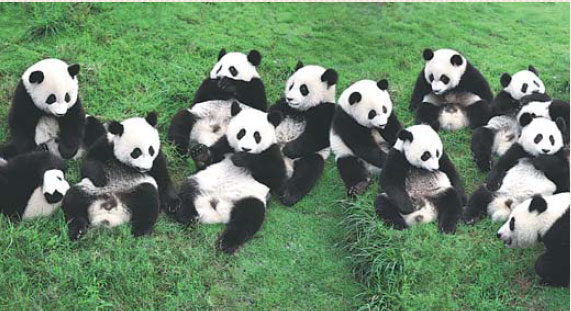Viewers of the movie Kung Fu Panda 3, released in China and the United States in January,were interested in the fictional Panda Village to which the hero Po returns with his long-lostfather.
Some foreign viewers said they were keen to visit Qingcheng Mountain in Sichuan provincebecause the scenery of the Panda Village amazed them.
They said the mountain, as portrayed in the movie, seems to have a peaceful environment. In themovie, Po says he can only find inner peace on the mountain, and that he derives the power heuses in kung fu from there.
Raman Hui, director of the promotional music video for Kung Fu Panda 3, said the scriptwritingteam visited Sichuan many times for inspiration.
It was not the first time the elements of Sichuan were featured in Kung Fu Panda.
When Kung Fu Panda 2 made Chinese audiences roar with laughter after hitting the mainlandscreens in May 2011, viewers saw the animated flick incorporate many cultural icons ofChengdu.
Qingcheng Mountain, spicy dandan noodles, mapo tofu and hot pot all appear in Kung Fu Panda2, chief of the city's information office Xiong Yan said.
The introduction of the Sichuan elements inadvertently fits into a larger trend in which Hollywoodis actively courting Chinese audiences' interest.
DreamWorks Animation SKG Inc's CEO Jef rey Katzenberg had expressed concern about thepandas' habitat when Kung Fu Panda premiered in Cannes, France, three days after the quakein 2008.
He and his team arrived in Chengdu for a two-day stay in October 2008. They visited theChengdu Research Base of Giant Panda Breeding and Qingcheng Mountain.
Katzenberg and his crew also sampled local specialties, such as dandan noodles. The CEOenjoyed his stay so much that he delayed his departure by private plane by two hours, Xiongsaid.
Katzenberg proposed including Sichuan elements in the sequel as a result of the trip. Theirexperiences of petting a newborn panda - later named Ah Bao after the film's protagonist - at theChengdu breeding base served as the inspiration for the development of Po's character in thesecond film, Xiong said.
"It was in the base that the baby panda inspired the Kung Fu Panda character Po and that we gotthe inspiration for the image of Po's master, shifu, from a red panda," the production director ofKung Fu Panda 2 Raymond Zibach said.
Qingcheng Mountain provided abundant inspiration for DreamWorks' creative team. Uponarriving at the mountain's base, the team was greeted by about 50 disciples of the Qingchengmartial arts sect, who performed shadowboxing.
Peacock Lord Shen's graceful and fluid shadowboxing style is believed to come from the Taoistmaster Liu Suibin, who performed for the team.
The visitors were dazzled by the mountain's lush greenery and murmuring streams. DirectorJennifer Yuh Nelson described the place as the Peace Valley.
They said they would likely include the mountain in the sequel. The wooden hut in the film isbased on the likeness of Qingcheng's structures and the mountain's Pavilion of Nature is featuredat the film's end.
The pavilion is very interesting and inspiring, as it combines natural material with traditionalarchitectural styles, Zibach said.
The Chinese characters for the famous mountain, which inspired many of the film's verdantlandscapes, appear twice in the animated work.
Katzenberg, who believed China will be the world's largest film market in a decade, said theKung Fu Panda franchise was a love letter from Hollywood to China.
The subtle incorporation of Chinese culture has become a stepping stone for Hollywood to enterthe Chinese market, he said.
"The Chinese elements in Kung Fu Panda were well received by Chinese audiences, and thefilm broke the Chinese box office record for highest-grossing animated feature," Katzenbergsaid.
Kung Fu Panda 2 provides a more thorough depiction of Chinese culture, which has not alwaysbeen done in Western movies, according to South Korean director Park Jin Bum.
Chengdu's publicity coup has served as a role model for Chinese cities to use Hollywoodblockbusters to build their image, Xiong said.
|

Happy panda families in a local reserve. Sichuan is renowned as the birthplace of therare animal.
|
(China Daily 09/28/2016 page37)


 京公网安备:
京公网安备:
